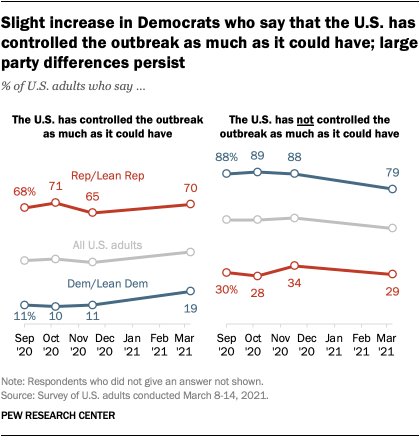The percentage of Americans following news of the coronavirus outbreak very closely has slipped to its lowest level since the beginning of the pandemic, but the large partisan gap in attention to that news remains, a new Pew Research Center survey has found.
Overall, 31% of adults say they are following news about the pandemic very closely, according to the survey of 12,045 U.S. adults conducted March 8-14, 2021, on the Center’s American Trends Panel, the first time this question was asked during Joe Biden’s presidency. That is down from 37% in a survey conducted in late November.
Over the past year, Pew Research Center has tracked Americans’ views on the COVID-19 pandemic, and this survey sought to measure how much attention the public has paid to it over time, their assessment of how it was handled and whether it was made into a bigger deal or smaller deal than it really is.
To do this, 12,045 U.S. adults were surveyed from March 8-14, 2021. Everyone who took part is a member of the Center’s American Trends Panel (ATP), an online survey panel that is recruited through national, random sampling of residential addresses. This way nearly all U.S. adults have a chance of selection. The survey is weighted to be representative of the U.S. adult population by gender, race, ethnicity, partisan affiliation, education and other categories. Read more about the ATP’s methodology.
Here are the questions used for the report, along with responses, and its methodology. This is the latest report in Pew Research Center’s ongoing investigation of the state of news, information and journalism in the digital age, a research program funded by The Pew Charitable Trusts, with generous support from the John S. and James L. Knight Foundation.
In late March 2020, during the early stages of the outbreak, over half of all Americans (57%) were following news about the coronavirus very closely – a percentage that marked the high point in public attention.
One finding consistent with late 2020 surveys is that Democrats and those who lean to the Democratic Party are much more likely to follow news of the outbreak very closely than Republicans and Republican leaners. In the new survey, 40% of Democrats are paying that much attention to news of the outbreak, compared with 23% of Republicans.
That party divide did not exist early in the pandemic but emerged in the summer and held throughout the fall and winter of 2020. In November 2020, for example, 47% of Democrats were paying very close attention, compared with 28% of Republicans. In March 2020, about half of each party (53% of Democrats and 48% of Republicans) were following pandemic news very closely.
Some shift in Democrats’ views of how the virus has been treated and handled
When asked if the coronavirus outbreak has been made into a bigger deal or smaller deal than it really is, or has been approached about right, a plurality of all adults (43%) now say it has been handled about right. About a third (34%) say it has been made into a bigger deal, and about a quarter (23%) say it has been made into a smaller deal.
The large partisan differences on this issue that were seen throughout the past year are also evident in the March 2021 survey. Five times as many Republicans and GOP leaners (60%) as Democrats and leaners (12%) say the pandemic has been exaggerated. At the same time, Democrats are about four times as likely as Republicans (34% vs. 9%) to say it has been downplayed.
Those Republican numbers have stayed stable over months, but there is some movement among Democrats in the new survey. Since the November 2020 survey, the portion of Democrats who now say the outbreak has been downplayed has dropped from 45% to 34%. Meanwhile, the percentage of Democrats saying it has been approached about right has risen from 42% to 53%. As noted in other Pew Research Center findings, Democrats have been more likely than Republicans to see the virus as a public health threat.
Another key COVID-19 issue that has produced a strong partisan divide is whether the U.S. has or has not controlled the coronavirus pandemic as much as it could have.
Overall, in the new survey, 42% of all Americans say the U.S. has done as much as it could, while 56% say it has not. Among Republicans, seven-in-ten say the nation has done as much as it could (70%), while 29% say the U.S. has fallen short. Those numbers are reversed for Democrats, with 19% saying the U.S. controlled the outbreak as much as it could and 79% saying it has not.
Republicans’ response is consistent with their views in surveys last fall. But again, there is a detectable shift among Democrats in the new survey. The 19% who now say the U.S. has done as much as it could to control COVID-19 – while still a small number – is higher than the 11% who said that last November. At the same time, there has been about a 10 percentage point drop in the portion of Democrats (79%) who now say the nation did not do as much as it could to control the outbreak.
Note: Here are the questions used for the report, along with responses, and its methodology.





